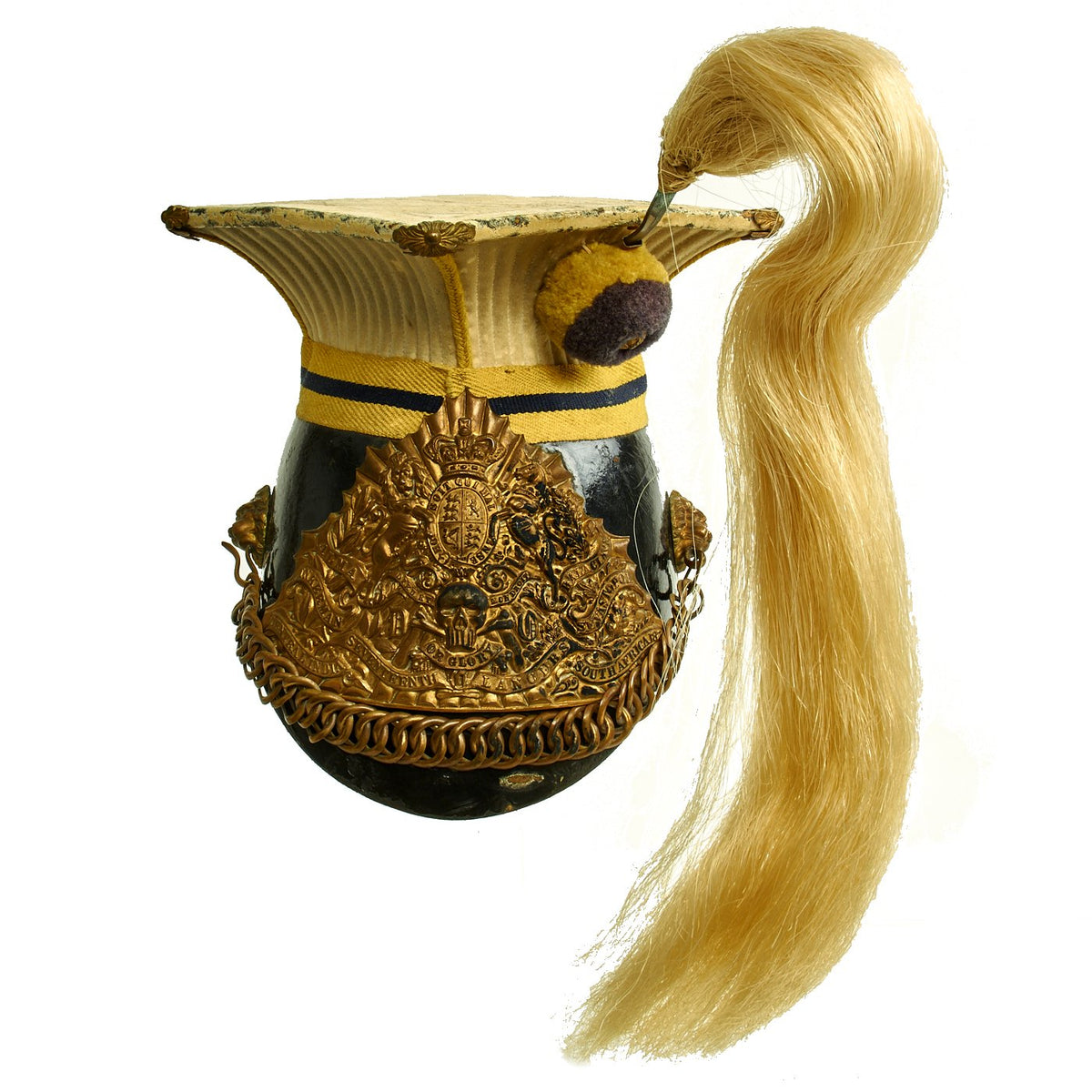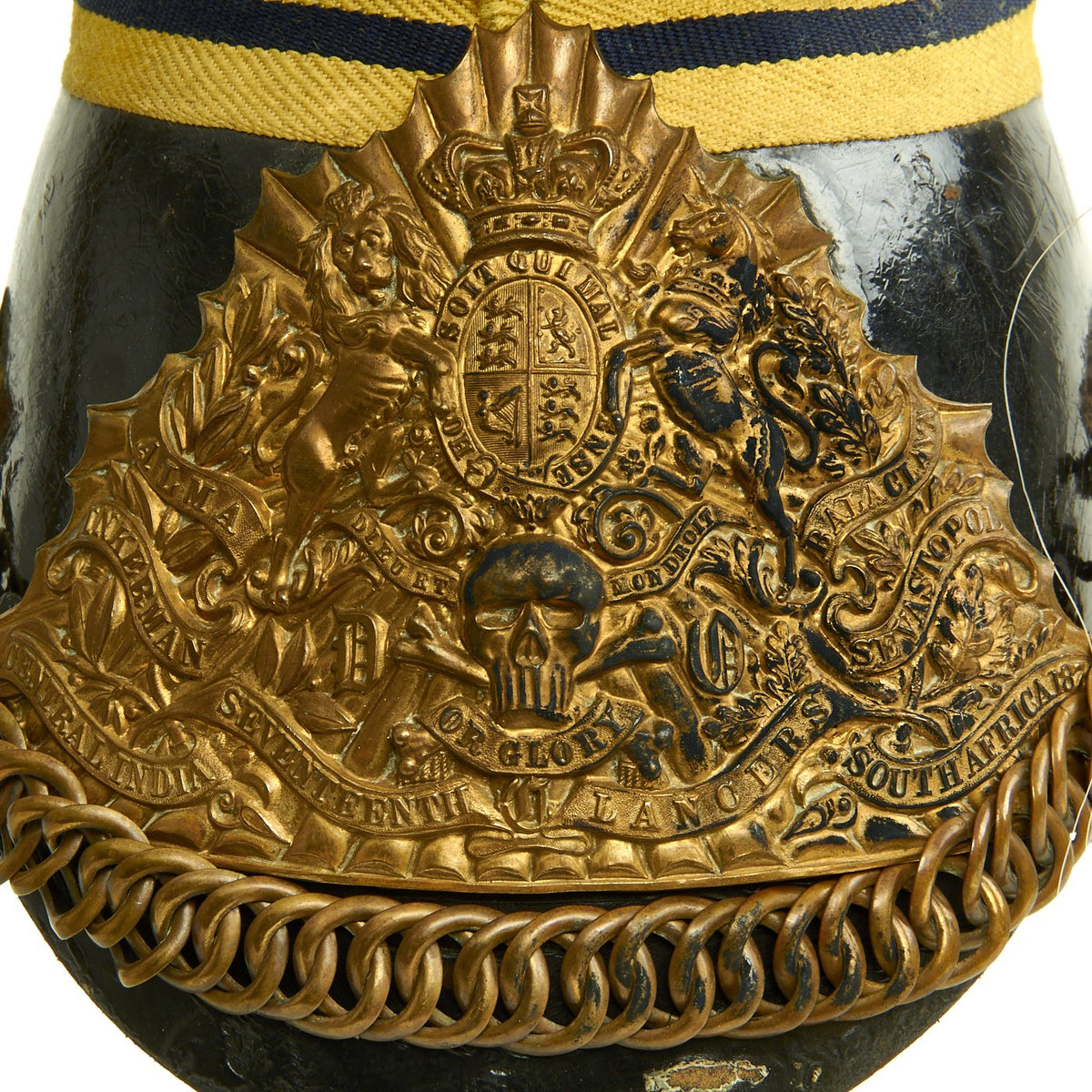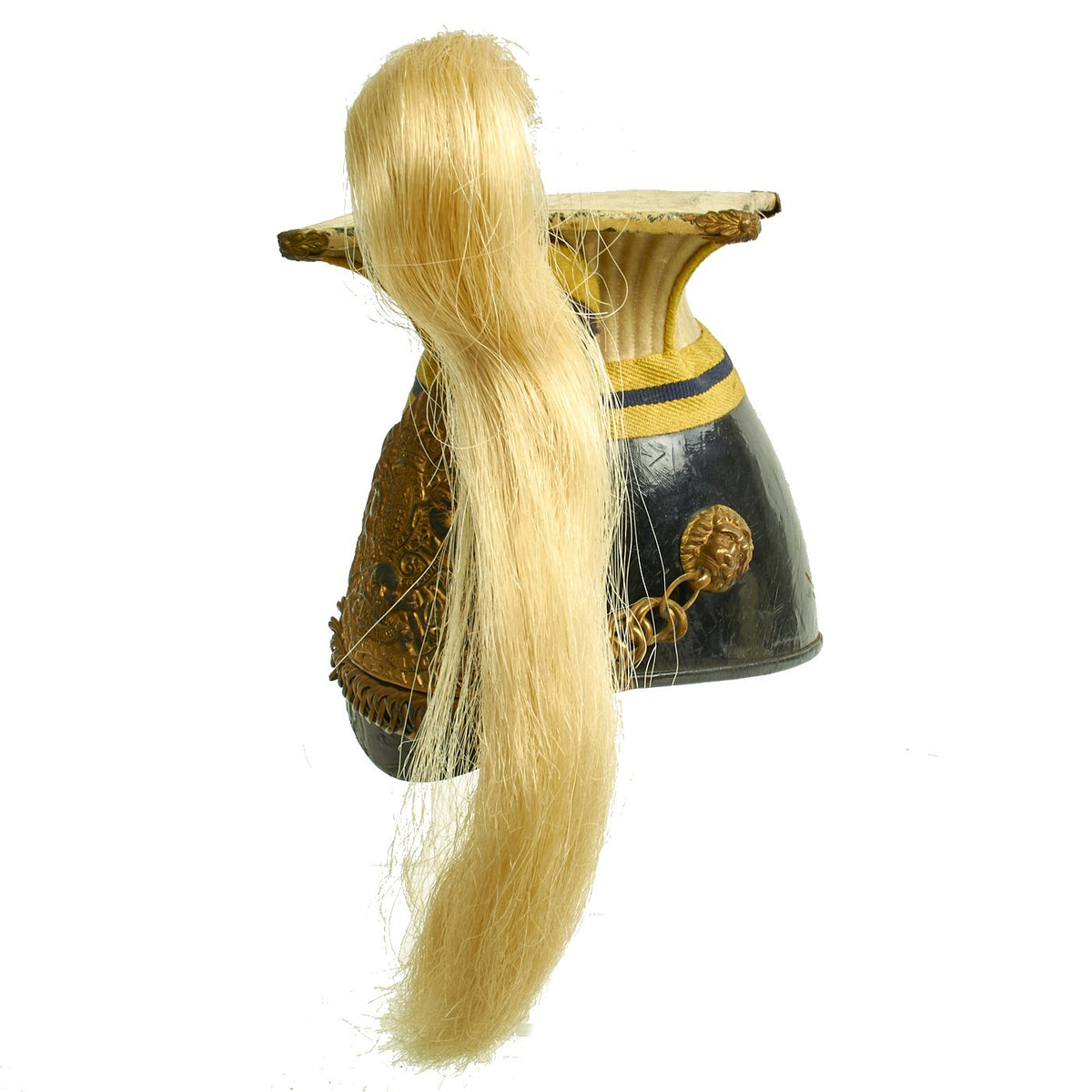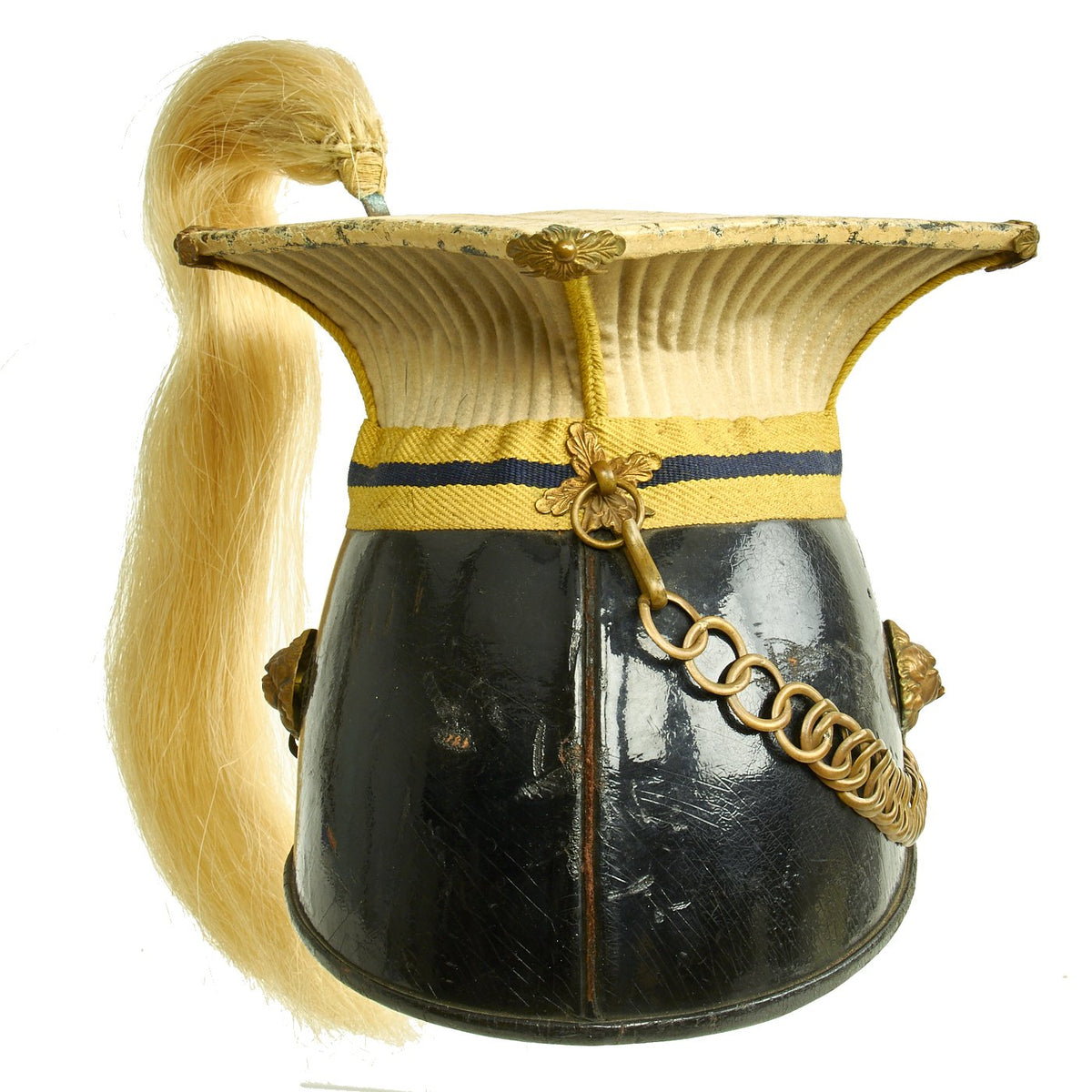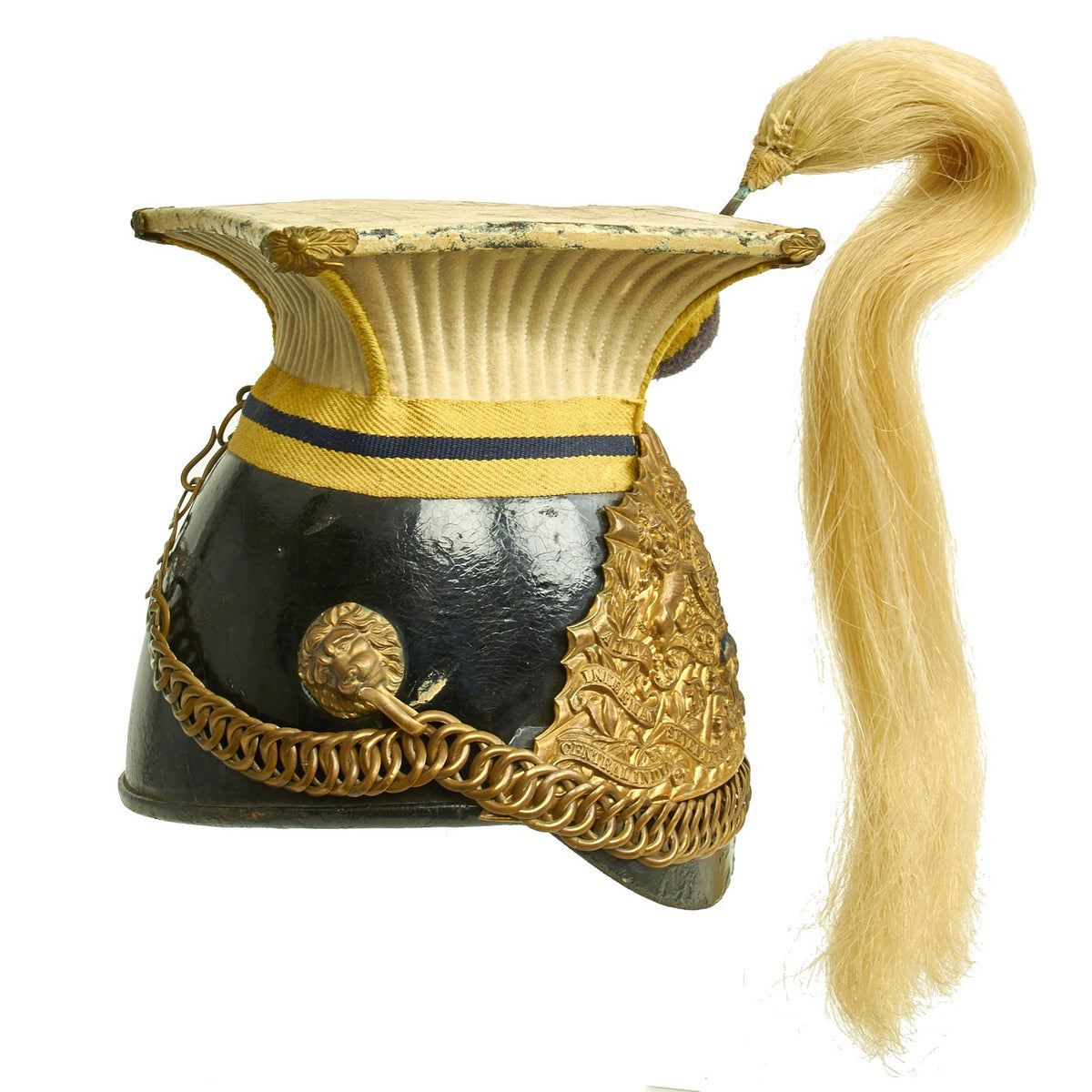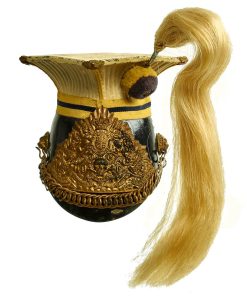Original British Victorian Era 17th Lancers Other Ranks Chapka Helmet – Duke of Cambridge’s Own Original Items
$ 1.995,00 $ 498,75
Original Item: Only One Available. One of the most romantic style helmets ever issued in the British military is this CHAPKA and was used exclusively by mounted lancers. The chapka, or lance cap, was an item of headdress originally worn by the legendary Polish Uhlan lancer regiments. British forces encountered Polish lancers wearing the Czapka Rogatywka (Horned Cap) in French service during the Napoleonic Wars. The British Army’s lancer regiments, formed after the Waterloo campaign, subsequently adopted the chapka, which was also adopted by other units throughout Europe.
This fine other ranks 17th Lancers Chapka features a brass helmet plate, illustrating the Royal coat-of-arms, composed of a shield within an oval garter inscribed “HONI SOIT QUI MAL Y PENSE”, flanked by a lion at the left and a unicorn at the right, surmounted by the Victorian crown, with a ribbon banner below inscribed “DIEU ET MON DROIT”, the arms above the 17th Lancers insignia illustrating a skull backed by cross bones, with the regimental ribbon banner below inscribed “OR GLORY”, the insignia framed by three Old English letters, a “D” at the left, a “C” below and a “O” at the right (the acronym for Duke of Cambridge’s Own), with a long ribbon banner at the base inscribed “SEVENTEENTH LANCERS”, with three stacked ribbon banners inscribed with battle honours on either side, the three at the left inscribed “ALMA, INKERMAN, CENTRAL INDIA” and backed by branches of laurel leaves, the three at the right inscribed “BALACLAVA, SEVASTOPOL, SOUTH AFRICA 1879” and backed by branches of oak leaves.
This Chapka helmet features a white horsehair plume. It is offered in truly excellent condition with full chin scales and lining. Size is approximately a 58cm or US 7 1/4. This is a splendid and truly classic example of a British Lancer’s Helmet from the height of the British Empire.
The 17th Lancers (Duke of Cambridge’s Own) was a cavalry regiment of the British Army, raised in 1759 and notable for its participation in the Charge of the Light Brigade during the Crimean War. The regiment was amalgamated with the 21st Lancers to form the 17th/21st Lancers in 1922.
In December 1857 the regiment arrived in India to reinforce the effort to suppress the Indian rebellion against British rule. By the time the regiment was prepared for service, the rebellion was effectively over, although it did take part in the pursuit of Tatya Tope, the rebel leader. During the course of the pursuit, Lieutenant Evelyn Wood earned the Victoria Cross for gallantry. The regiment returned to England in 1865. The regiment became the 17th Regiment of Lancers in August 1861. When, in 1876, it gained Prince George, Duke of Cambridge as its colonel-in-chief, the regiment adopted the title of the 17th (The Duke of Cambridge’s Own) Lancers.
The regiment was sent to Natal Colony for service in the Anglo-Zulu War and fought at the Battle of Ulundi under Sir Drury Curzon Drury-Lowe in July 1879.[45] The regiment was deployed inside a large British infantry square during the attack by the Zulu Army, which had surrounded the British. When the attack appeared to be wavering, the regiment was ordered to advance: their charge routed the warriors with heavy loss and proved to be decisive. The regiment returned to India the same year, remaining there until about 1890 when they returned to England.
Second Boer War
In February 1900 a contingent from the regiment, comprising Lieutenant-Colonel E. F. Herbert and 500 troops, was deployed to South Africa for service in the Second Boer War, and arrived to Cape Town on the SS Victorian early the next month. The contingent missed the large pitched battles, but still saw action during the war. In 1900, Sergeant Brian Lawrence won the regiment’s fifth and final Victoria Cross at Essenbosch Farm.[49] The contingent’s most significant action was at the Battle of Elands River (Modderfontein) in September 1901. C Squadron was attacked by a unit of Boers under the command of Jan Smuts; the Lancers mistakenly assumed the unit was friendly because of their attire. The Boers immediately opened fire, attacking from both the front and the rear. The Lancers suffered further casualties at a closed gate that slowed them down. Only Captain Sandeman, the squadron commander, and Lieutenant Lord Vivian survived. The regiment suffered 29 killed and 41 wounded before surrendering, while Boer losses were just one killed and six wounded.
They stayed in South Africa throughout the war, which ended June 1902 with the Peace of Vereeniging. Four months later, 540 officers and men left Cape Town on the SS German in late September 1902, and arrived at Southampton in late October, when they were posted to Edinburgh.
Fast Shipping with Professional Packaging
Thanks to our longstanding association with UPS FedEx DHL, and other major international carriers, we are able to provide a range of shipping options. Our warehouse staff is expertly trained and will wrap your products according to our exact and precise specifications. Prior to shipping, your goods will be thoroughly examined and securely secured. We ship to thousands clients each day across multiple countries. This shows how we're dedicated to be the largest retailer on the internet. Warehouses and distribution centres can be located throughout Europe as well as the USA.
Note: Orders with more than one item will be assigned a processing date depending on the item.
Before shipping before shipping, we'll conduct a thorough inspection of the items you have ordered. Today, the majority of orders will be delivered within 48 hours. The delivery time will be between 3-7 days.
Returns
The stock is dynamic and we cannot completely manage it because multiple stakeholders are involved, including our factory and warehouse. So the actual stock may alter at any time. It's possible that you may not receive your order once the order has been made.
Our policy is valid for a period of 30 days. If you don't receive the product within 30 days, we are not able to issue a refund or an exchange.
You can only return an item if it is unused and in the same state as the day you received it. You must have the item in its original packaging.
Related products
Uncategorized
Armored Burgonet Helmet & Polearm from Scottish Castle Leith Hall Circa 1700 Original Items
Uncategorized
Uncategorized
Uncategorized
Uncategorized
Uncategorized
Uncategorized
Uncategorized
Uncategorized
Uncategorized
Angolan Rebel 1970s era 60mm Inert Display Mortar from Angolan Civil War Original Items
Uncategorized
Armoured Fighting Vehicles of the World: AFVs of World War One (Hardcover Book) New Made Items
Uncategorized
Australian WWII Owen MK1 Machine Carbine SMG Custom Fabricated Replica with Sling Original Items
Uncategorized
Uncategorized
Uncategorized
Uncategorized
Uncategorized
